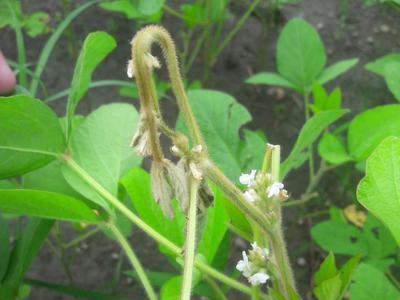Soybean Girdle Beetle
Obereopsis brevis
Insect
In a Nutshell
- Two circular cuts on branch or stem.
- Drooping and drying of leaves.
- Wilting and death of young plants.
- Beetle has yellow-red colored head and chest, brown wing covers.
- Larvae appear white with a dark head.
Can also be found in
Symptoms
Visible symptoms can be observed at the seedling stage characterized by two circular cuts on the plant's branch or stem. Seedlings and young plants are wilted or dead while older plants' leaves are just wilted or brown, and all dried up. Circular rings will be seen on affected branches. The infested part above the cut will dry up eventually. At a later infestation stage, the plant is severed at about 15 - 25 cm above the ground.
Recommendations

Organic Control
To this day, no effective organic treatment is available. Alternative options for control of Soybean girdle beetle are limited to the use of preventive and cultural measures.

Chemical Control
Always consider an integrated approach with preventive measures together with biological treatments, if available. If the damage exceeds the economic threshold of 5%, you can apply NSKE 5% or azadirachtin 10000 ppm @ 1 ml/1 l water to avoid Girdle beetle to lay eggs. Cartap hydrochloride granular 4 kg/acre can be spread at sowing time. Spray Lambda-cyhalothrin 5 EC @ 10 ml or Dimethoate 25 EC @ 2 ml per liter water at 30 - 35 days after sowing and repeat the procedure 15 - 20 days after first spraying, if infestation is observed. Chlorantraniliprole 18.5% SC @ 150 ml/ha, Profenophos and Trizophos are also suggested at vegetative stage or flowering.
What caused it?
The symptoms are mostly caused by the white, soft-bodied, dark-headed larvae of Oberopsis brevis. The adult beetle is characterized by its yellow-red head and chest coloration, and brown colored bases of elytra (wing covers). The eggs are laid in between girdles by the females. Larvae will bore into stem and feed on the inside, forming a tunnel in the stem. The infested part above the cut is unable to get sufficient nutrition and dries up. Severe yield losses occur are the result. Ideal climatic conditions for the beetle are temperatures between 24 - 31°C and high relative humidity.
Preventive Measures
- Use tolerant varieties, like NRC-12 or NRC-7.
- Distribute the seeds evenly while sowing at the proper time (i.e.
- at the onset of monsoon).
- Avoid excessive use of nitrogenous fertilizer.
- Collect and destroy infested plant parts at least once every 10 days.
- After harvest, destroy the crop residues.
- Crop rotation is recommended, but avoid intercropping with maize or sorghum.
- Prepare the soil for the next season by deep plowing in the summer months.
- Shaincha can be used as a trap crop.



